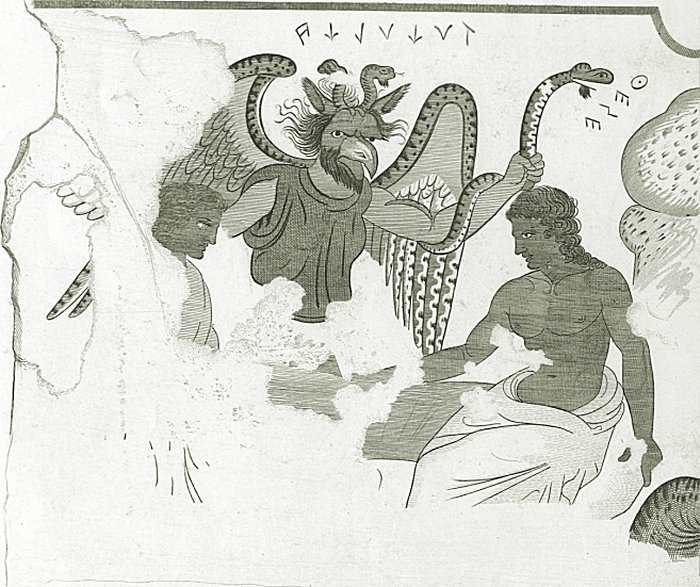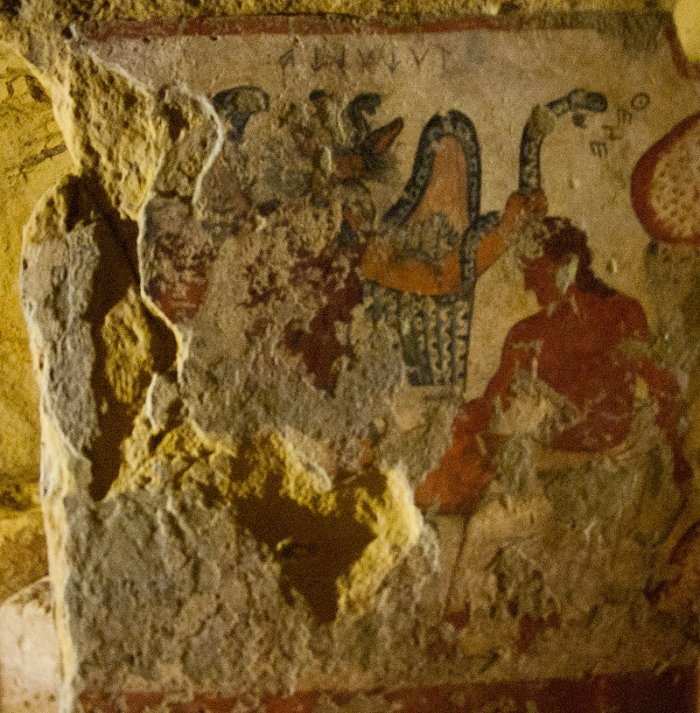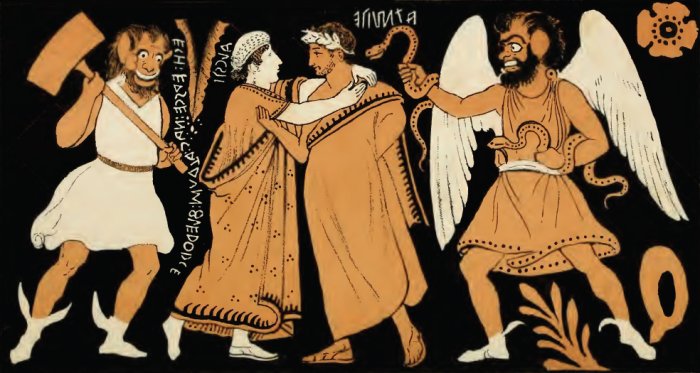A. Sutherland – AncientPages.com – In ancient Etruscan beliefs, there is a strange monster to which many scholars refer to a man because of the animal face and facial hair that can resemble a beard.

1870 reconstructed drawing of Tuchulcha painting in the Tomb of Orcus II. In this drawing, Tuchulcha is depicted along with Theseus. Image credit: Schulz dis. e inc. – Public Domain
Others believe this mostly unusual deity known as Tuchulcha can be of the opposite Sєx. He used to wear a woman’s dress, his skin was pale pink, and he appeared to have breasts.
Tuchulcha (Tulchulca or Tuxulxa) is a wicked Etruscan God with demonic attributes. Still, his appearance was long unknown until his statue was finally unearthed in the summer of 1974 at Tarquinia Necropolis, Italy.
The Etruscans lived between Florence and Rome and had a very sophisticated culture and technology. They were wealthy, luxury-loving people fond of banqueting and music. Their civilization flourished for almost a thousand years before being absorbed by the Roman Empire.
The Etruscans were a profoundly religious society in which goddesses and demons played a crucial role in their religion and scenes of the human sacrifice they traditionally practiced. Demons were frightening and grotesque characters, often painted on the walls of large tombs. They traditionally guided the ᴅᴇᴀᴅ to the afterlife.
The two most famous demons are Tuchulcha and Charun – the announcer of death and divider of families, the guide on the road to Hades, and the porter at the gate of hell.
In many respects, he is an Etruscan equivalent to Charon, a psychopomp, the ferryman of Hades, the Greek underworld. Tuchulcha’s appearance seems to confirm imagined attributes. He has a hooked, thick nose, an eagle’s beak, long ears like a donkey’s, a mouth with fleshy lips, and a small conical beard. Instead of hair, this grotesque monster has snakes growing from the head, carrying additional snakes to scare the new souls.

Fresco from the Tomb of Orcus II, Tarquinia, Italy. The daemon Tuchulcha is watching the hero Tese (Theseus) playing a boardgame with his friend. Image credit: Robin Iversen Rönnlund – CC BY-SA 3.0
The monster Tuchulcha was often depicted along with other demons of death. Interestingly, in “inscriptions on tomb paintings and sarcophagi, no gods or demons of Hades are mentioned or illustrated before the fourth century. B.C. From then on, however, pictures of creatures that peopled the life after death are common.” 1
Generally, scholars refer to the monster as a Man because of its animal face and facial hair, which can resemble a beard. In “Etruscan Myth, Sacred History, and Legend,” Nancy Thomson de Grummond wrote that Tuchulcha could be of the opposite Sєx, claiming to wear a woman’s dress, have pale pink skin, and seems to have breasts.
Other researchers have supported her theory regarding this monster. However, many others point out that both Sєxes wore the chiton at the time.
With extreme devotion, the Etruscans worshipped the souls of the ᴅᴇᴀᴅ. They believed in the real hell, to which souls of the ᴅᴇᴀᴅ were brought by Charun, an old animal-like man with wings and a heavy hammer, who represents the underworld psychopomp in Etruscan myths.
There are many such demons on the Etruscan tombs’ painted walls. One is Mantis, the king of hell, adorned with a crown, wings, and a torch in his hand. Also, the frightening Tuchulcha belonged to this group.

Red-figure amphora from Vulci . The tuchulcha is on the right side, with two snakes coiled around the arms. Image credit: – Drawing after original by George Dennis, The Cities and Cemeteries of Etruria , 1848.
Interestingly, Tuchulcha was never a popular figure to be depicted.
One appearance of this frightening deity of the underworld was recognized in a fresco, “The Story Of Theseus Visiting the Underworld,” dated to 300 BC and ᴀssociated with the mysterious Tomb of Orcus II in Tarquinia.
In this tomb, one scene shows Theseus, the mythical king and founder-hero of Athens, and his companion, Pirithous, seated on either side of a table, playing a board game. Behind them rises a fearsome winged demon with a vulture’s beak, ᴀss’s ears, and snake-infested hair. This monster brandishes a great, bearded serpent over Theseus’ head; his name is Tuchulcha, a purely Etruscan demon. The monster Tuchulcha is watching them and threatening Theseus with a great snake. 1
Tuchulcha’s function in the underworld is not entirely known. However, it is believed he was busy punishing or scaring the souls of those who misbehaved when alive.
Whether Tuchulcha played an essential role in the underworld is hard to say. Undoubtedly, his position could not be compared to that of King Hades and Queen Persephone.
Written by – A. Sutherland – AncientPages.com Senior Staff Writer
Copyright © AncientPages.com All rights reserved. This material may not be published, broadcast, rewritten or redistributed in whole or part without thexpress written permission of AncientPages.com
Expand for references
References:
Nancy de Grummond, Etruscan Myth, Sacred History and Legend
Pecchioni, Enio. The Etruscan Religion and Language Riddle
Bonfante Larissa, Etruscan Myths





